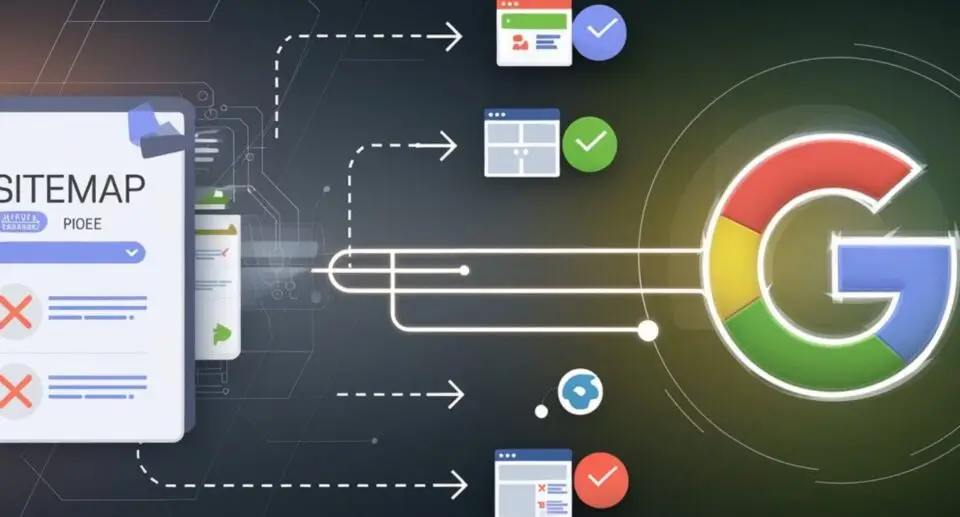Submit Sitemap to Google: 8 XML Mistakes to Avoid

INTRODUCTION
Have you ever spent months crafting high-quality content only to realize Google isn’t even indexing it properly? You’re not alone. Many websites struggle with poor visibility, not because of bad content, but due to technical missteps—especially in their XML sitemaps. If you don’t correctly submit sitemap to Google or unknowingly make certain mistakes, you risk sabotaging your rankings. In this guide, we’ll break down the most common XML sitemap errors and show you how to fix them for better SEO performance.
 Table of Contents
Table of Contents
- Why XML Sitemaps Are Crucial for SEO
- Tools & Platforms to Manage Sitemaps
- 8 Common XML Sitemap Mistakes to Avoid
- Content Optimization Tips for Sitemaps
- How to Measure and Monitor Sitemap Success
- Conclusion
- FAQs
Why XML Sitemaps Are Crucial for SEO
An XML sitemap is a file that lists all indexable pages on your site. It acts like a roadmap for search engines, helping them crawl and index your content efficiently. Submitting your sitemap to Google is one of the most foundational SEO steps submit sitemap to google.
Key Benefits:
- Ensures new and updated pages are crawled faster
- Improves visibility for deeper, less-linked pages
- Provides metadata like last updated dates and priority levels
Analogy: Think of your XML sitemap as a grocery store map. Without it, customers (search engines) might never find the organic aisle—no matter how good your produce is.
Tools & Platforms to Manage Sitemaps
Here are some trusted tools to create, validate, and submit your XML sitemaps:
- Google Search Console – Submit and monitor sitemap health
- Yoast SEO / Rank Math (WordPress) – Auto-generate and update sitemaps
- Screaming Frog SEO Spider – Crawl and audit sitemap structure
- XML-sitemaps.com – Generate XML files manually
- Sitebulb – In-depth sitemap analysis with visual graphs
8 Common XML Sitemap Mistakes to Avoid
1. Including Non-Indexable Pages
Impact: Wastes crawl budget and confuses Google. Pages marked with noindex, canonical to others, or duplicates shouldn’t be in your submit sitemap to google.
Fix: Only include indexable pages. Exclude /admin, /cart, and /thank-you pages.
 2. Not Updating the Sitemap Regularly
2. Not Updating the Sitemap Regularly
Impact: Search engines might not see your new or updated pages, delaying indexing.
Fix: Use dynamic sitemaps or plugins that auto-update (e.g., Yoast or Rank Math).
3. Submitting Multiple Sitemaps Incorrectly
Impact: Disorganized sitemaps confuse crawlers, leading to incomplete indexing.
Fix: Use a sitemap index file to structure multiple sitemaps clearly.
4. Sitemap Not Submitted to Google Search Console
Impact: Google may not even know your sitemap exists.
Fix: Manually submit sitemap to Google through Search Console and monitor for errors.
5. Exceeding Sitemap Size Limits
Impact: Sitemaps over 50MB or with more than 50,000 URLs may not be processed.
Fix: Split large sitemaps and organize them under a sitemap index file.
6. Poor URL Structure in Sitemaps
Impact: Mismatched URLs (http vs. https, www vs. non-www) cause crawl issues.
Fix: Ensure all URLs in your sitemap are fully qualified and consistent.
7. Including 404 or Redirected URLs
Impact: Lowers crawl efficiency and damages trust with search engines.
Fix: Run regular audits. Remove 404, 301, and 302 URLs from your submit sitemap to google.
8. Not Using Priority & Last Modified Tags
Impact: Google may miss your most important or recently updated content.
Fix: Add and tags where appropriate to signal relevance.
Bonus Tip: Validate before you submit!
✔️ Use GSC, Screaming Frog, or online XML validators to check for syntax, indexability, and consistency issues.
Content Optimization Tips for Sitemaps
Actionable Tips:
- Create different sitemaps for blog posts, products, and landing pages.
- Exclude “thin” content with low value.
- Keep file size small to avoid load issues.
Personal Example
When we onboarded a client with a massive e-commerce site, their sitemap included thousands of out-of-stock or 404 pages. After cleaning it up and resubmitting via Search Console, they saw a 48% increase in indexed pages within 6 weeks.
Case Study
A SaaS startup had never submitted their sitemap. After implementing Rank Math and uploading the XML sitemap to GSC, traffic from organic search increased by 35% in 2 months due to improved crawling and better visibility of their blog content submit sitemap to google.
How to Measure and Monitor Sitemap Success
 Metrics to Watch:
Metrics to Watch:
- Indexed vs. Submitted URLs (Google Search Console)
- Crawl stats and crawl rate trends
- Errors and warnings on sitemap files
Tools to Use:
- Google Search Console (Coverage > Sitemaps)
- Ahrefs Site Audit
- Screaming Frog + Log File Analyzer
Growth Hack: Set a monthly reminder to audit and validate your sitemap. A clean sitemap = faster indexing = better rankings.
Conclusion
Your sitemap isn’t just a “nice to have”—it’s a critical SEO tool. If you fail to submit sitemap to Google or make common XML errors, your amazing content may go unnoticed. Fix these 8 mistakes to ensure your sitemap boosts, not blocks, your rankings. Audit regularly, submit updates, and prioritize what matters most. You’ve worked hard to build your website—don’t let sitemap issues bury it.
Call to Action:
- Run a sitemap audit today and check your GSC reports.
- Need help fixing XML errors? Reach out and we’ll audit it for free submit sitemap to google.
FAQs
1. How do I submit a sitemap to Google?
Login to Google Search Console, go to the “Sitemaps” section, enter your sitemap URL, and click submit.
2. What should be included in an XML sitemap?
Only indexable, high-quality URLs that you want Google to crawl and rank.
3. How often should I update my sitemap?
Automatically, if possible. Otherwise, after publishing or deleting major content submit sitemap to google.
4. Can multiple sitemaps be submitted to Google?
Yes. Use a sitemap index file to organize them clearly.
5. Why is my sitemap showing errors in Search Console?
Likely due to syntax issues, broken URLs, or non-indexable pages. Use a validator to fix them submit sitemap to google.

 Table of Contents
Table of Contents 2. Not Updating the Sitemap Regularly
2. Not Updating the Sitemap Regularly

 Metrics to Watch:
Metrics to Watch:



